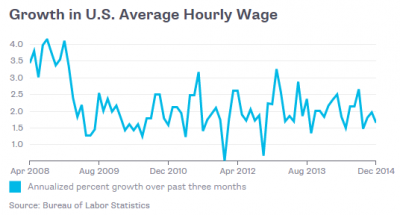Last term, I attended an outside lecture by Eric Rosengren, the president of Boston Federal Reserve. What particularly interested me was his statistics on the recent change in the U.S labor force. On surface, the total number of employed individuals has been increasing; the unemployment rate has declined to 5.6 percent, its lowest level since 2008. Some may interpret this job growth as a sign of economic recovery since the recession. However, Rosengren also showed us that the fall in unemployment is mostly due to the rise in the number of part timers (who would otherwise prefer full time positions). This finding makes it even harder to predict the future performance of U.S economy.
As we learned in Macro 101, Fed always has to make a trade off between unemployment and inflation rates. People like Rosengren believe that Fed should not rush to start raising the interest rate right now, but should focus on getting as many people attain meaningful employment (i.e. full time) as possible.
Another way to study the relationship between labor participation and economic growth is to observe the trend in wage. Bloomberg View posted a very interesting article last month titled “Great Job Growth! Now Where’s That Raise?”. The editors argue that despite the recent job growth, wages aren’t rising fast enough. According to their findings, “as of December, the average hourly wage for private-sector workers stood at $24.57, up only 1.7 percent from a year earlier”. Considering that the inflation rate has been approximately 1.7 percent during the same period, this means that workers have been earning just barely enough to keep up with the change in consumer prices.
As Bloomberg editors put it, the “U.S. workers are overdue for a raise”. In this way, they are similar to Rosengren in prioritizing labor market outcomes over interest rate.
Source: http://www.bloombergview.com/articles/2015-01-09/great-job-growth-now-wheres-that-raise

One Comment
If we look at median wages, they’ve fallen, so at least half the population is below where it was 20 years ago.
As to the monetary policy, it’s not clear that it’s effective at the zero lower bound. There’s not much evidence that quantitative easing did anything (and there’s no indication to date that easing off of QE is doing much of anything, either). So the unemployment-inflation tradeoff is moot. Furthermore, inflation is falling, not just due to energy price declines, but more broadly — and it’s falling from a level below the 2% rate which the Fed talks about. More as the term progresses!
Comments are closed.